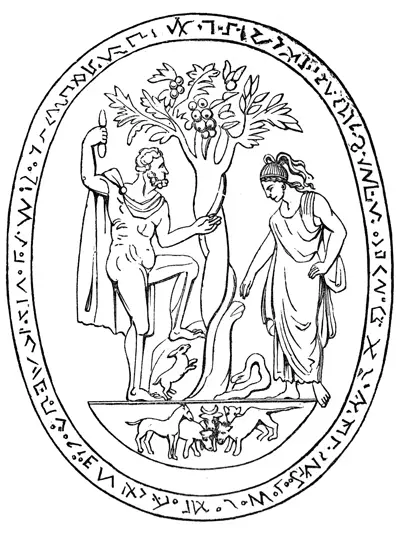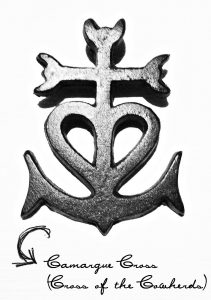In Ancient Greece, people believed in a polytheistic religion and many symbols deriving from the myths and stories of their gods represented very meanings in Ancient Greek culture and so there were various Ancient Greek Symbols that had various symbolic meanings attached to them. Some of them are listed below-
Ancient Greek Symbols
The Minotaur:
“Minotaur” is Greek for “Bull of Minos.” The bull was known in Crete as Asterion, a name shared with Minos’s foster father. The historical site of Knossos is usually identified as the site of the labyrinth. The Minotaur was eventually killed by Theseus. Minotaur was a large creature with the body of a man and the tail and head of a bull. As per Greek mythology, it was the unnatural offspring of the Cretan Queen Pasiphae and a majestic bull. It usually devoured humans to sustain itself. It stayed in the Labyrinth which was a huge maze which was built by Daedalus and Icarus at the orders of King Minos. The minotaur devoured youths and maidens every year before he was ultimately killed by Theseus.
Sun of Vergina:
In every form, the Sun of Vergina symbolized Virginity: Goddess Athena was a Virgin, so this Sun was associated with her. Although it is a Panhellenic Symbol, it became famous due to the Macedonians who were using it as Symbol of the Argead Dynasty. In the typical 16-pointed Sun, the 4 rays represent the 4 elements: Earth-Ocean-Fire-Air.
The other 12 rays represent the 12 Gods of Olympus.

Arrow:
in ancient Greece, the arrow symbolized war, power, swiftness, the rays of the sun, knowledge as well as deities such as the Greek god Apollo and goddess Artemis (both hunters), the Hindu weather god, Rudra; and various gods of sexual attraction: Eros (Greek), Cupid (Roman), Kama (Hindu).Labrys is the term for a double-headed Axe, known to the Classical Greeks as piles or safaris, and to the Romans as a bipennis.

The labrys symbolism is found in Minoan, Thracian, Greek, and Byzantine religion, mythology, and art, dating from the Middle Bronze Age onwards. The labrys also appears in African religious symbolism and mythology (see Shango).
The Asclepius wand or Asclepius rod is an Ancient Greek Symbols associated with astrology and with healing the sick through Greek Medicine. The rod of Asclepius symbolizes the healing arts by combining the serpent, which is shedding its skin is a symbol of rebirth and fertility, with the staff, a symbol of authority befitting the god of Medicine.
Spider:
Linked to treachery and death in many cultures, it was seen as a “spinner of fate” in ancient Greek myths – the goddess Arachne turned into a spider by her jealous rival Athena.

The Gorgon In Greek mythology was a vicious female monster with sharp fangs who was a protective deity from early religious concepts. Her power was so strong that anyone attempting to look upon her would be turned to stone; therefore, such images were put upon items from temples to wine kraters for protection. There were three of them: Medusa, Stheno, and Euryale. Only Medusa was mortal, the other two are immortal.
Sphinx:
The Greek sphinx would devour travelers who failed to answer her riddle. The masonic sphinx “is the guardian of the Mysteries and is the Mysteries summarized in a symbol. Their secret is the answer to her question. The initiate must know it or lose the life of the Mysteries. If he can and does answer, the Sphinx dies for him, because in this respect the Mysteries have given up their meaning.
Hercules Knot
It is an Ancient Greek symbol that is known by many names such as Love Knot, Knot of Hercules, Heracles Knot, etc. It represents loyalty, commitment, and never-ending love. It is popular with Greek marriages and the present phrase ‘tying the knot’ (denoting marriage) has probably originated from this symbol. It was initially used as a healing charm in Ancient Egypt and also as protection for the Greeks and Romans. It is made with two entwined ropes that symbolize the legendary fertility of Hercules, the Greek God. At weddings, the bride wore it in her girdle which was to be ceremonially untied by the groom. In present times, due to its ease of manipulation and fast holding capacity, it serves numerous purposes. It is called the ‘reef knot.’
Cornucopia
It is a horn-shaped container that overflows with nuts, flowers, and festive items and thus is a renowned Greek symbol of abundance and nourishment. Cornucopia is also called the ‘horn of plenty.” As per Greek mythology, it was formed when Alpheus turned into a bull to fight Hercules. It was Hercules who broke one of Alpheus’ horns and gave it to the nymphs who fruit-filled it and gave it its name. In present times, it is depicted as a horn-shaped wicker basket that is filled with fruit and vegetables. It is a typical festive gift item and is depicted in flags, seals, etc.
Solomon’s Knot
It is also known as Solomon’s Cross is a traditional decorative style of Greek culture that consists of two doubly interlinked closed loops. It is more of a link rather than a knot. The interconnectivity of the two loops of the Soloman’s Knot has several legends attached to it. It has served symbolic interpretations across many historical eras. Much like the Buddhist Endless Knot, it has no visible beginning or ending and thus represents immortality and eternity. It is also called Lover’s Knot as it appears similar to two entwined figures.
Labrys
It is an archaic symbol which was a both-sided axe, used by the Greek Thundergod Zeus to invoke storms. It was also a holy religious symbol of the Cretans. It was also called pelekys or Sagaris. It was supposedly closely connected with the Ancient Minoan Civilization where it represented authority and was a symbol of the Mother Goddess. It also signified butterfly, rebirth, and transformation. It was mostly seen with women and is a symbol of Hellenic Neopaganism. In present times, it is an LGBTQ symbol that shows matriarchal, female power, and lesbianism.
Caduceus
It is the symbol of Hermes, the messenger of the Gods, according to Greek mythology. It features a winged staff in the center with two snakes winding around it. The winged staff is supposedly the rod of Asclepius, an ancient demigod of medicine who healed the sick and revived the dead back of life. The staff was originally bound with two white ribbons but the snakes coiled around it and remained forever together. Caduceus first appeared in the Jewish Torah and is presently used as a symbol of medicine.
Cornucopia
It is a horn-shaped container that overflows with nuts, flowers, and festive items and thus is a renowned Greek symbol of abundance and nourishment. Cornucopia is also called the ‘horn of plenty.” As per Greek mythology, it was formed when Alpheus turned into a bull to fight Hercules. It was Hercules who broke one of Alpheus’ horns and gave it to the nymphs who fruit-filled it and gave it its name. In present times, it is depicted as a horn-shaped wicker basket that is filled with fruit and vegetables. It is a typical festive gift item and is depicted in flags, seals, etc.
Labyrinth
Labyrinth in Greek literature means a confusing and elaborate maze that was designed by Daedalus on the order of the king of Minos to imprison a minotaur. It symbolizes wholeness and spiraling into a path that has a purpose through meandering. It has been used for meditation and prayers for years.
Sun wheel
The sun wheel is an ancient symbol of sin which consists of a circle with a cross inside it. It represents the seasonal systems common in a tropical year which consists of four seasons, while the sun is a symbolization of power and magic. It even became a part of Christian iconography.
Gorgons
Gorgons were the terrifying monsters in the Greek mythologies who had snakes instead of hair and anyone who saw their face would turn into stone. The most famous gorgon was medusa. It was also a protective deity as their images were sometimes placed on items for protection.
The Omphalos
The Omphalos was a stone that symbolized power in ancient Greek religious stories. In Greek, the word means navel. It is said that they could be used for direct communication with the gods although their use was complicated.The Omphalos was a stone that symbolized power in ancient Greek religious stories. In Greek, the word means navel. It is said that they could be used for direct communication with the gods although their use was complicated.